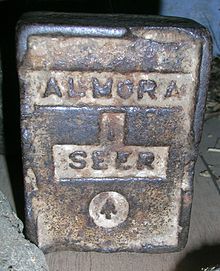- Seer (unit)
-
"Sihr" redirects here. For the ice hockey organization, see Society for International Hockey Research.For other uses, see Seer (disambiguation).
A Seer (also sihr) is an obsolete unit of mass and volume that was used in parts of Asia.
Contents
India
British Indian
units of massIn India, the seer (Government seer) was defined by the Standards of Weights and Measures Act (No. 89 of 1956, amended in 1960 and 1964) as being exactly equal to 0.93310 kg (2.057131 lb). However there were many local variants of the seer in India.
Bengal 80 tolas of rice South India mass of 24 current rupees Chennai (formerly Madras) approx 25 lb (9.33 kg) Juggerat mass of 40 local rupees Mumbai (formerly Bombay) 28 lb (10.45 kg) called the Old Seer Oman, Nepal and Pakistan
In Aden (Oman), Nepal, and Pakistan a seer was approximately 0.93310 kg (2.057 lb) derived from the Government seer of British colonial days.
Afghanistan
In Afghanistan, it was a unit of mass, approximately 7.066 kg (15.58 lb).
Persia
In Persia (and later Iran), it was two units.
- The metric seer was 74.22 g (2.618 oz)
- The seer (sihr) was 160 g (5.64 oz)
Sri Lanka
In Sri Lanka, it was a measure of capacity, approximately 1.86 pint (1.024 litres)
See also
References
"Seer". Sizes, grades, units, scales, calendars, chronologies. http://www.sizes.com/units/seer.htm. Retrieved 2007-02-19.

This standards- or measurement-related article is a stub. You can help Wikipedia by expanding it.

